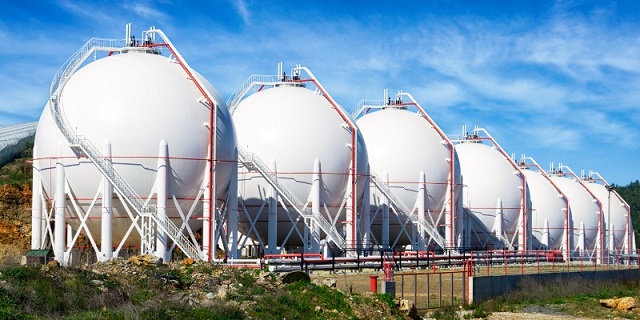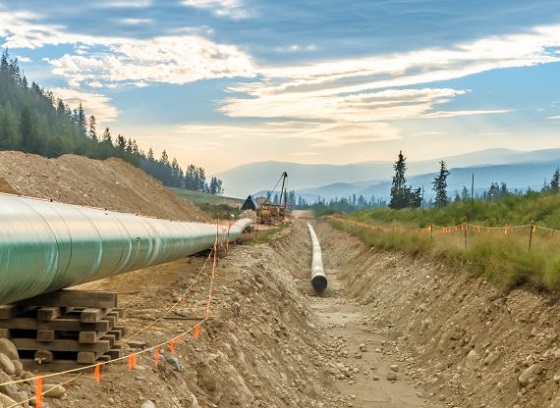Energy
U.S. halt on LNG exports presents new opportunity for Canada

From the Fraser Institute
By Julio Mejía and Elmira Aliakbari
The Biden administration recently paused the approval of permits for liquefied natural gas (LNG) exports, which will force U.S. allies to explore alternative sources of LNG, opening the door for Canada. In fact, if Canadian policymakers remove certain regulatory hurdles, they can help position Canada as a leading global provider of clean and reliable natural gas while also helping create jobs and prosperity in British Columbia, Alberta and beyond.
Following Putin’s invasion of Ukraine, President Biden committed to supplying steady LNG to the European Union, aiming to reduce reliance on Russian gas. By 2023, the United States had become the world’s top LNG exporter, with several European countries importing more than half of America’s LNG exports. However, President Biden also pledged to transition the U.S. away from fossil fuels so he’s paused LNG exports to appease his environmentalist constituency ahead of the upcoming U.S. presidential election.
But this pause comes at a crucial time for European countries grappling with energy shortages and rising prices. Last year, energy-intensive industries in Europe scaled back or halted production amid soaring energy prices, and Germany, Europe’s largest economy, narrowly avoided a recession caused by energy supply shortages. To keep the lights on, European countries have been forced to revert to coal-fired power plants, an energy source that contributes more CO2 emissions than natural gas.
Following the U.S. decision, European and Asian countries (including China) are exploring alternative LNG suppliers, again creating a potential void that Canada could fill. Japan and Germany have already turned to Canada.
Canada’s vast natural resources hold the potential to make a significant positive impact on global energy security, reliability, and emissions reduction by reducing reliance on coal. Despite possessing “the most prolific and lower-cost North American gas resources,” as emphasized by McKinsey’s recent report, development in Canada has encountered challenges largely due to government regulatory barriers. Presently, Canada lacks any operational LNG export terminals, unlike the U.S., which has 27 such facilities. The LNG Canada development in B.C. is slated to become Canada’s first operational facility, expected to begin exporting by 2025.
The absence of LNG export infrastructure in Canada has led domestic natural gas producers to depend on U.S. LNG facilities for exporting. However, with the recent halt on approving new LNG projects south of the border, there’s an urgent need for Canada to establish its own infrastructure if we’re going to seize this opportunity to be a global LNG supplier.
Forecasts indicate steady and growing global demand for LNG. McKinsey’s recent report anticipates an annual increase in global LNG demand of 1.5 per cent to 3 per cent to 2035. And according to the latest report by the International Energy Agency (IEA), limited new LNG production means supply will remain tight.
Despite promising opportunities, various government initiatives including CleanBC (the B.C. government’s plan to reduce greenhouse gas emissions,) the Trudeau government’s emissions caps on the oil and gas sector, and federal Bill C-69 (which added more red tape and complexity to the assessment process for major energy projects) have created uncertainty and deterred, if not outright prohibited, investment in the sector.
Canada has an opportunity to provide clean and reliable natural gas to our allies, help improve the world’s energy security and reduce global greenhouse gas emissions. The federal and provincial governments must remove regulatory barriers to allow for the needed infrastructure and investment in the LNG sector, which will also provide jobs and prosperity here at home.
Authors:
Energy
75 per cent of Canadians support the construction of new pipelines to the East Coast and British Columbia

-
71 per cent of Canadians find the approval process too long.
-
67 per cent of Quebecers support the Marinvest Energy natural gas project.
“While there has always been a clear majority of Canadians supporting the development of new pipelines, it seems that the trade dispute has helped firm up this support,” says Gabriel Giguère, senior policy analyst at the MEI. “From coast to coast, Canadians appreciate the importance of the energy industry to our prosperity.”
Three-quarters of Canadians support constructing new pipelines to ports in Eastern Canada or British Columbia in order to diversify our export markets for oil and gas.
This proportion is 14 percentage points higher than it was last year, with the “strongly agree” category accounting for almost all of the increase.
For its part, Marinvest Energy’s natural gas pipeline and liquefaction plant project, in Quebec’s North Shore region, is supported by 67 per cent of Quebecers polled, who see it as a way to reduce European dependence on Russian natural gas.
Moreover, 54 per cent of Quebecers now say they support the development of the province’s own oil resources. This represents a six-point increase over last year.
“This year again, we see that this preconceived notion according to which Quebecers oppose energy development is false,” says Mr. Giguère. “Quebecers’ increased support for pipeline projects should signal to politicians that there is social acceptability, whatever certain lobby groups might think.”
It is also the case that seven in ten Canadians (71 per cent) think the approval process for major projects, including environmental assessments, is too long and should be reformed. In Quebec, 63 per cent are of this opinion.
The federal Bill C-5 and Quebec Bill 5 seem to respond to these concerns by trying to accelerate the approval of certain large projects selected by governments.
In July, the MEI recommended a revision of the assessment process in order to make it swift by default instead of creating a way to bypass it as Bill C-5 and Bill 5 do.
“Canadians understand that the burdensome assessment process undermines our prosperity and the creation of good, well-paid jobs,” says Mr. Giguère. “While the recent bills to accelerate projects of national interest are a step in the right direction, it would be better simply to reform the assessment process so that it works, rather than creating a workaround.”
A sample of 1,159 Canadians aged 18 and older were surveyed between November 27 and December 2, 2025. The results are accurate to within ± 3.5 percentage points, 19 times out of 20.
Business
Geopolitics no longer drives oil prices the way it used to

This article supplied by Troy Media.
Oil markets are shrugging off war and sanctions, a sign that oversupply now matters more than disruption
Oil producers hoping geopolitics would lift prices are running into a harsh reality. Markets are brushing off wars and sanctions as traders focus instead on expectations of a deep and persistent oil glut.
That shift was evident last week. Despite several geopolitical developments that would once have pushed prices higher, including the U.S. seizure of a Venezuelan crude tanker and fresh Ukrainian strikes on Russian energy infrastructure, oil markets barely reacted, with prices ending the week lower.
Brent crude settled Friday at US$61.12 a barrel and U.S. West Texas Intermediate at US$57.44, capping a weekly drop of more than four per cent.
Instead of responding to disruption headlines, markets were reacting to a different risk. Bearish sentiment, rather than geopolitics, continued to dominate as expectations of a “2026 glut” took centre stage.
At the heart of that outlook is a growing supply overhang. The oil market is grappling with whether sanctioned Russian and Iranian cargoes should still be counted as supply. That uncertainty helps explain why prices have been slow to react to a glut that is already forming on the water, said Carol Ryan, writing for The Wall Street Journal.
The scale of that buildup is significant. There are 1.4 billion barrels of oil “on the water,” 24 per cent higher than the average for this time of year between 2016 and 2024, according to oil analytics firm Vortexa. These figures capture shipments still in transit or cargoes that have yet to find a buyer, a clear sign that supply is running ahead of immediate demand.
Official forecasts have reinforced that view. Last week, the International Energy Agency trimmed its projected 2026 surplus to 3.84 million barrels per day, down from 4.09 million barrels per day projected previously. Even so, the IEA still sees a large oversupply relative to global demand.
Demand growth offers little relief. The IEA expects growth of 830 kb/d (thousand barrels per day) in 2025 and 860 kb/d in 2026, with petrochemical feedstocks accounting for a larger share of incremental demand. That pace remains modest against the volume of supply coming to market.
OPEC, however, has offered a different assessment. In its latest report, the group pointed to a near balance, forecasting demand for OPEC+ crude averaging about 43 million barrels per day in 2026, roughly in line with what it produced in November.
Reflecting that confidence. OPEC+ kept policy steady late in November, pausing planned output hikes for the first quarter of 2026 while more than three million barrels per day of cuts remain in place. Those measures are supportive in theory, but markets have shown little sign of being persuaded.
Recent geopolitical events underline that scepticism. The ongoing Russia-Ukraine war and Ukrainian strikes on Russian energy infrastructure, including reported hits on facilities such as the Slavneft-YANOS refinery in Yaroslavl, again failed to lift prices. Russia-Ukraine headlines pulled prices down more than strikes lifted them, according to media reports, suggesting traders were more attuned to “peace deal” risk than to supply disruption.
Washington’s move against Venezuelan crude shipments offered another test. The U.S. seizure of a Venezuelan tanker, the first formal seizure under the 2019 sanctions framework, had a muted price impact, writes Marcin Frackiewicz of Oilprice.com.
Venezuela’s exports fell sharply in the days that followed, but markets remained largely unmoved. One explanation is that Venezuela’s output is no longer large enough to tighten global balances the way it once did, and that abundant global supply has reduced the geopolitical premium.
Taken together, the signal is hard to miss. Oil producers, including in Canada, face a reality check in a market that no longer rewards headlines, only discipline and demand.
Toronto-based Rashid Husain Syed is a highly regarded analyst specializing in energy and politics, particularly in the Middle East. In addition to his contributions to local and international newspapers, Rashid frequently lends his expertise as a speaker at global conferences. Organizations such as the Department of Energy in Washington and the International Energy Agency in Paris have sought his insights on global energy matters.
Troy Media empowers Canadian community news outlets by providing independent, insightful analysis and commentary. Our mission is to support local media in helping Canadians stay informed and engaged by delivering reliable content that strengthens community connections and deepens understanding across the country.
-

 Health2 days ago
Health2 days agoFDA warns ‘breast binder’ manufacturers to stop marketing to gender-confused girls
-

 International2 days ago
International2 days ago2025: The Year The Narrative Changed
-

 Business1 day ago
Business1 day agoThere’s No Bias at CBC News, You Say? Well, OK…
-

 Uncategorized19 hours ago
Uncategorized19 hours agoMortgaging Canada’s energy future — the hidden costs of the Carney-Smith pipeline deal
-

 Agriculture2 days ago
Agriculture2 days agoSupply Management Is Making Your Christmas Dinner More Expensive
-

 Daily Caller2 days ago
Daily Caller2 days agoTrump Reportedly Escalates Pressure On Venezuela With Another Oil Tanker Seizure
-

 Health2 days ago
Health2 days agoAll 12 Vaccinated vs. Unvaccinated Studies Found the Same Thing: Unvaccinated Children Are Far Healthier
-

 International19 hours ago
International19 hours agoAustralian PM booed at Bondi vigil as crowd screams “shame!”













